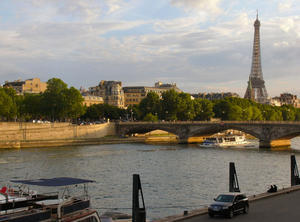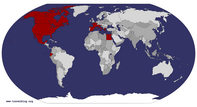Advertisement
Published: November 15th 2006

 Paris
Paris
Paris, Lie de France - FranceDec 19, 1993
*
City official name :Paris
*
Founded date : *
Location :Lie de France Province
*
Elavation :? ft (? m)
*
Area :Approximately ? square miles (? km²).
*
Facts :Paris is the capital city of France and a French département (75). Situated on the banks of the river Seine in north-central France, it is also the capital of the Île-de-France région (also known as "Paris Region"), which encompasses Paris and its suburbs. Paris had an estimated mid-2004 population of 2,144,700. The Paris urban area, extending well beyond the city boundaries, has today an estimated population of 9.93 million. The Paris metropolitan area (including satellite towns) stood at 11.5 million in 1999 and is one of the most populated metropolitan areas in Europe.
The Paris region is France's most dynamic centre of economic activity. It produces more than a quarter of France's wealth, with a GDP of €478.7 billion (US$595.3 billion) in 2005. With La Défense, the largest business district in Europe, the Paris urban area (unité urbaine) also hosts the head offices of almost half of the major French companies, as well as the offices of major international firms. Paris is a leading global

 Paris
Paris
Paris, Lie de France - Francecultural, business and political centre and has a major international influence in fashion, gastronomy and the arts. It is widely regarded as one of the world's major global cities, with the headquarters of international organisations such as UNESCO, the OECD, the ICC, or the informal Paris Club.
The city, which is renowned for its defining neo-classical architecture, hosts many museums and galleries and has an active nightlife. The most recognisable symbol of Paris is the 324 metre (1,063 ft) Eiffel Tower on the banks of the Seine. Dubbed "the City of Light" (la Ville Lumière) since the 19th century, Paris is regarded by some as one of the most romantic cities in the world. It is also the most visited city in the world, with more than 30 million visitors per year.
Origin of the name
The city derives its name from the Gallic Parisii tribe. The city, known as Lutetia (/lutetja/) during the Roman Empire, began to adopt its present-day name towards the end of the Roman era. Since the early 20th century, Paris has been known in French slang as Paname (; Moi j'suis d'Paname, i.e. "I'm from Paname"), a slang name that has been regaining

 Paris
Paris
Paris, Lie de France - Francefavor with young people in recent years. Another sobriquet for Paris is 'The City of Light' (La Ville-lumière), owing to its early adoption of street-lighting.
The inhabitants of Paris are known as Parisians in English and as Parisiens in French. Parisians are sometimes called Parigots ( (help·info)) in French slang, a term often used pejoratively by people outside the Paris Region, but sometimes considered endearing by Parisians themselves.
The earliest signs of permanent habitation in the Paris area date from around 4200 BC. Celtic migrants began to settle the area from 250 BC, and the Parisii tribe of these, known as boatmen and traders, established a settlement near the river Seine from around then.
Westward Roman conquest and the ensuing Gallic War overtook the Paris basin from 52 BC, and by the end of the century Paris' Île de la Cité island and Left Bank Sainte Geneviève Hill had become the Roman town of Lutetia. Gallo-Roman Lutèce would expand over the following centuries, becoming a prosperous city with palaces, a forum, baths, temples, theatres and an amphitheatre.
As other Roman cities, early Lutetia was structured as a regular grid (300 feet squares), with the cardo maximus

 Paris
Paris
Paris, Lie de France - France(main North-South axis) being the current Rue Saint-Jacques, and the decumani (East-West axis) were parallel to current Bd Saint-Germain and Rue des Ecoles. The "point zero", or groma of this grid was probably located at the southwest corner of the forum, which corresponds to nos. 172 and 174 of Rue Saint-Jacques: the highest point on the Saint-Geneviève hill.
The collapse of the Roman empire and third-century Germanic invasions sent the city into a period of decline: by 400 AD Lutèce, largely abandoned by its inhabitants, was little more than a garrison town entrenched into its hastily fortified central island. The city would reclaim its original "Paris" appellation towards the end of the Roman occupation
Around AD 500, Paris was the capital of the Frankish king Clovis I, who commissioned the first cathedral and abbey. On the death of Clovis, the Frankish kingdom was divided, and Paris became the capital of a much smaller sovereign state. By the time of the Carolingian dynasty (9th century), Paris was little more than a feudal county stronghold. The Counts of Paris gradually rose to prominence and eventually wielded greater power than the Kings of Francia occidentalis. Odo, Count of Paris was elected

 Paris
Paris
Paris, Lie de France - Franceking in place of the incumbent Charles the Fat, namely for the fame he gained in his defence of Paris during the Viking siege of 885-886. Although the Cité island had survived the Viking attacks, most of the unprotected Left Bank city was destroyed; rather than rebuild there, after drying marshlands to the north of the island, Paris began to expand onto the Right Bank. In 987 AD, Hugh Capet, Count of Paris, was elected King of France, founding the Capetian dynasty which would raise Paris to become France's capital.
From 1190, King Philip Augustus enclosed Paris on both banks with a wall that had the Louvre as its western fortress and in 1200 chartered the University of Paris which brought visitors from across Europe. It was during this period that the city developed a spatial distribution of activities that exists even today: the central island housed government and ecclesiastical institutions, the left bank became a scholastic centre with the University and colleges, while the right bank developed as the centre of commerce and trade around the central Les Halles marketplace.
Paris lost its position as seat of the French realm while occupied by the English-ally Burgundians during

 Paris
Paris
Paris, Lie de France - Francethe Hundred Years' War, but regained its title when Charles VII reclaimed the city in 1437; although Paris was capital once again, the Crown preferred to remain in its Loire Valley castles. During the French Wars of Religion, Paris was a stronghold of the Catholic party, culminating in the St. Bartholomew's Day massacre (1572). King Henry IV re-established the royal court in Paris in 1594 after he captured the city from the Catholic party. During the Fronde, Parisians rose in rebellion and the royal family fled the city (1648). King Louis XIV then moved the royal court permanently to Versailles in 1682. A century later, Paris was the centre stage for the French Revolution, with the Storming of the Bastille in 1789 and the overthrow of the monarchy in 1792.
The Industrial Revolution, the French Second Empire, and the Belle Époque brought Paris the greatest development in its history. From the 1840s, rail transport allowed an unprecedented flow of migrants into Paris attracted by employment in the new industries in the suburbs. The city underwent a massive renovation under Napoleon III and his préfet Haussmann, who leveled entire districts of narrow-winding medieval streets to create the network of wide

 Paris
Paris
Paris, Lie de France - Franceavenues and neo-classical façades of modern Paris.
Cholera epidemics in 1832 and 1849 affected the population of Paris — the 1832 epidemic alone claimed 20,000 of the then population of 650,000. Paris also suffered greatly from the siege ending the Franco-Prussian War (1870-1871), and the ensuing civil war Commune of Paris (1871) killed thousands and sent many of Paris's administrative centres (and city archives) up in flames.
Paris recovered rapidly from these events to host the famous Universal Expositions of the late nineteenth century. The Eiffel Tower was built for the French Revolution centennial 1889 Universal Exposition, as a "temporary" display of architectural engineering prowess but remained the world's tallest building until 1930, and today is the city's best-known landmark. The first line of the Paris Métro opened for the 1900 Universal Exposition and was an attraction in itself for visitors from the world over. Paris's World's Fair years also consolidated its position in the tourist industry and as an attractive setting for international technology and trade shows.
During World War I, Paris was at the forefront of the war effort, having been spared a German invasion by the French and British victory at the First Battle

 Paris
Paris
Paris, Lie de France - Franceof the Marne in 1914. In 1918-1919, it was the scene of Allied victory parades and peace negotiations. In the inter-war period Paris was famed for its cultural and artistic communities and its nightlife. The city became a melting pot of artists from around the world, from exiled Russian composer Stravinsky and Spanish painters Picasso and Dalí to American writer Hemingway. In June 1940, five weeks after the start of the German attack on France, a partially evacuated Paris fell to German occupation forces who remained until the city was liberated by the 2nd Armored Division of General Leclerc in late August 1944. Central Paris endured WW II practically unscathed, as there were no strategic targets for bombers (train stations in central Paris are terminal stations; major factories were located in the suburbs), and also because German General von Choltitz refused to carry out Hitler's order that all Parisian monuments be destroyed before any German retreat.
In the post-war era, Paris experienced its largest development since the end of the Belle Époque in 1914. The suburbs began to expand considerably, with the construction of large social estates known as cités and the beginning of the business district La Défense.

 Paris
Paris
Paris, Lie de France - FranceA comprehensive express subway network, the RER, was built to complement the Métro and serve the distant suburbs, while a network of freeways was developed in the suburbs, centered on the Périphérique expressway circling around the city.
Since the 1970s, many inner suburbs of Paris (especially the eastern ones) have experienced deindustrialization, and the once-thriving cités have gradually become ghettos for immigrants and oases of unemployment. At the same time, the City of Paris (within its Périphérique ring) and the western and southern suburbs have successfully shifted their economic base from traditional manufacturing to high value-added services and high-tech manufacturing, generating great wealth for their residents whose per capita income is among the highest in Europe. The resulting widening social gap between these two areas has led to periodic unrest since the mid-1980s, such as the 2005 riots which largely concentrated in the northeastern suburbs.
Advertisement
Tot: 0.475s; Tpl: 0.016s; cc: 17; qc: 87; dbt: 0.2799s; 1; m:domysql w:travelblog (10.17.0.13); sld: 1;
; mem: 1.3mb















